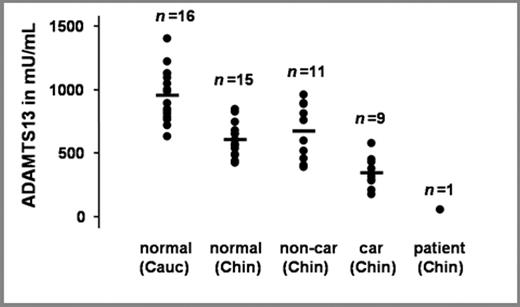Abstract
ADAMTS13 is a metalloprotease that cleaves the A2-domain of von Willebrand factor, resulting in a normal processed protein. A defective or blocked enzyme causes a severe disorder, called thrombotic thrombocytopenic purpura (TTP). The need for research tools, both clinical and fundamental, hence is urgent. To bypass the need for substantial amounts of highly purified antigen in order to produce monoclonal antibodies, we used genetic immunisation and an ADAMTS13 specific screening assay. Using this assay, high affinity hybridoma clones were selected and allowed us to set up a sensitive and reproducible sandwich ELISA. This antigen test is specific, as (i) plasma from a patient with acquired TTP but presenting without inhibitor, did not contain antigen and (ii) the binding of recombinant ADAMTS13 was inhibited by increasing amounts of ADAMTS13 in normal plasma. Antigen levels were measured relative to a standard of pooled normal human Caucasian plasma (n=20) that was arbitrarily set to 1 U/mL. Antigen levels in congenital TTP samples (34 ± 21 mU/mL, n =2) (mean ± SD) as well as in samples from patients with acquired TTP (231 ± 287 mU/mL, n=11) were clearly reduced when compared to normal Caucasian donors (951 ± 206 mU/mL, n=16). The samples from the above mentioned acquired TTP patients were taken before plasma exchange (PE). We found that antigen levels (513 ± 223, n = 11) raised significantly after PE therapy.
Hence, ADAMTS13 antigen is severely reduced (< 0.23 U/mL) at presentation in most (81%) of the investigated acquired TTP cases. Therefore, ADAMTS13 antigen is an important parameter in both congenital and acquired TTP. We also showed that the antigen assay could distinguish mutation carriers (341 ± 125 mU/mL, n = 9) from non-carriers (668 ± 208 mU/mL, n = 11) within a genotyped family of a congenital Chinese TTP patient. We also found that normal Chinese donors have a significantly lower antigen titre (601 ± 129 mU/mL, n=15) than Caucasian normals. The consequences of this finding, on the molecular level, are however not clear.
Author notes
Corresponding author



